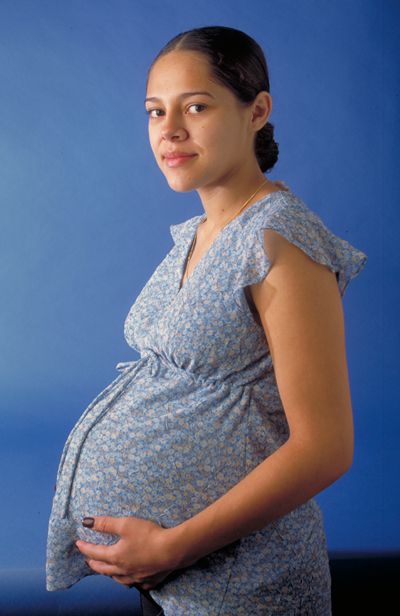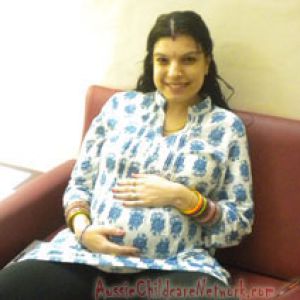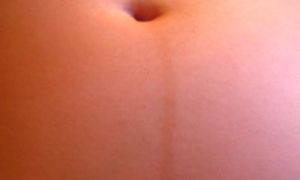Pregnancy is the carrying of one or more offspring, known as a foetus or embryo, inside the womb of a female. In a pregnancy, there can be multiple gestations, as in the case of twins or triplets. Human pregnancy is the most studied of all mammalian pregnancies. Childbirth usually occurs about 38 weeks after conception; i.e., approximately 40 weeks from the last normal menstrual period (LNMP) in humans. The World Health Organization defines normal term for delivery as between 37 weeks and 42 weeks.
Progression
Stages in prenatal development, with weeks and months numbered from last menstrual period.
Initiation
Pregnancy occurs as the result of the female gamete or oocyte merging with the male gamete, spermatozoon, in a process referred to, in medicine, as fertilization, or more commonly known as "conception". After the point of fertilization, it is referred to as a zygote or fertilized egg. The fusion of male and female gametes usually occurs through the act of sexual intercourse, resulting in spontaneous pregnancy. However, the advent of artificial insemination and in vitro fertilisation have also made achieving pregnancy possible in cases where sexual intercourse does not result in fertilization (e.g., through choice or male/female infertility).
The process of fertilization occurs in more than a single step, and the interruption of any of these can lead to a failure. Therefore, what is commonly known as "conception" is much more than the fusion between the female gamete and male spermatozoon. Through fertilization, the egg and sperm are saved: the egg is activated to begin its developmental program, and the haploid nuclei of the two gametes come together to form the genome of a new diploid organism
At the very beginning of the process, the sperm undergoes a series of changes which makes pregnancy likely to occur. As freshly ejaculated sperm is unable or poorly able to fertilize, the sperm undergoes the phenomenon called capacitation. It is estimated that during the ejaculation, 300,000,000 sperma is released, from which only 200 reach the oviduct. Capacitation is the process through which the spermatozoon is prepared for the merging with the egg. Capacitation occurs in 5 to 6 hours and it takes place once the sperm reaches the vagina. This is also the process through which the spermatozoon becomes hyperactivated and prepared for the acrosome reaction. In order to be able to fecundate the egg, the sperm must get through the coat surrounding the egg, the so called "zona pellucida". Once zona pellucida is penetrated, the sperm is able to reach the oocyte. But in order to get through the egg's coat, the sperm undergoes an acrosome reaction that provides it with and enzymatic drill which is able to penetrate zona pellucida. The acrosome itself is a modified lysosome, situated on the anterior part of the head of the sperm.
Once a sperm penetrates the zona pellucida, it binds to and fuses with the plasma membrane of the oocyte. Binding occurs at the posterior (post-acrosomal) region of the sperm head. After binding occurs, the egg must also undergo a series of metabolic and physical changes which may influence the further development of the zygote. These changes are called in medicine egg activation, mainly because prior to fertilization, the egg is in a latent state.
Methods to assist reproduction also include intracytoplasmic sperm injection, gamete intrafallopian transfer (GIFT), zygote intrafallopian transfer (ZIFT), and embryo cryopreservation (frozen fertilized egg and sperm). These techniques are considered as alternatives to get pregnant by women who have tried unsuccessfully for at least one year. It is estimated that in the United States, more than 6 million adults, or 10% of the adult population, are affected by infertility.
Prenatal Period
Prenatal defines the period occurring "around the time of birth", specifically from 22 completed weeks (154 days) of gestation (the time when birth weight is normally 500 g) to 7 completed days after birth.
Legal regulations in different countries include gestation age beginning from 16 to 22 weeks (5 months) before birth.
Postnatal Period
The postnatal period begins immediately after the birth of a child and then extends for about six weeks. During this period, the mother's body returns to pre pregnancy conditions as far as uterus size and hormone levels are concerned.
Perinatal Period
The perinatal period is immediately before to after birth. Depending on the definition, it starts between the 20th to 28th week of gestation and ends between 1 to 4 weeks after birth (the word "perinatal" is a hybrid of the Greek "peri-" meaning 'around or about' and "natal" from the Latin "natus" meaning "birth.").
Duration
The expected date of delivery (EDD) is 40 weeks counting from the first day of the last menstrual period (LMP), and birth usually occurs between 37 and 42 weeks. The actual pregnancy duration is typically 38 weeks after conception. Though pregnancy begins at conception, it is more convenient to date from the first day of a woman's last menstrual period, or from the date of conception if known. Starting from one of these dates, the expected date of delivery can be calculated using the Naegele's rule for estimating date of delivery. A more accurate and sophisticated algorithm takes into account other variables, such as whether this is the first or subsequent child (i.e., pregnant woman is a primip or a multip, respectively), ethnicity, parental age, length of menstrual cycle, and menstrual regularity.
Pregnancy is considered "at term" when gestation attains 37 complete weeks but is less than 42 (between 259 and 294 days since LMP). Events before completion of 37 weeks (259 days) are considered preterm; from week 42 (294 days) events are considered postterm. When a pregnancy exceeds 42 weeks (294 days), the risk of complications for woman and fetus increases significantly. As such, obstetricians usually prefer to induce labour, in an uncomplicated pregnancy, at some stage between 41 and 42 weeks.
Recent medical literature prefers the terminology preterm and postterm to premature and postmature. Preterm and postterm are unambiguously defined as above, whereas premature and postmature have historical meaning and relate more to the infant's size and state of development rather than to the stage of pregnancy.
Fewer than 5% of births occur on the due date; 50% of births are within a week of the due date, and almost 90% within 2 weeks. It is much more useful and accurate, therefore, to consider a range of due dates, rather than one specific day, with some online due date calculators providing this information.
Accurate dating of pregnancy is important, because it is used in calculating the results of various prenatal tests (for example, in the triple test). A decision may be made to induce labour if a fetus is perceived to be overdue. Furthermore, if LMP and ultrasound dating predict different respective due dates, with the latter being later, this might signify slowed fetal growth and therefore require closer review.
The age of viability has been receding because of continued medical progress. Whereas it used to be 28 weeks, it has been brought back to as early as 23, or even 22 weeks in some countries.
Childbirth
Childbirth is the process whereby an infant is born. It is considered by many to be the beginning of the infant's life, and age is defined relative to this event in most cultures.
A woman is considered to be in labour when she begins experiencing regular uterine contractions, accompanied by changes of her cervix – primarily effacement and dilation. While childbirth is widely experienced as painful, some women do report painless labours, while others find that concentrating on the birth helps to quicken labour and lessen the sensations. Most births are successful vaginal births, but sometimes complications arise and a woman may undergo a caesarean section.
During the time immediately after birth, both the mother and the baby are hormonally cued to bond, the mother through the release of oxytocin, a hormone also released during breastfeeding.
References
http://en.wikipedia.org/wiki/Pregnancy








